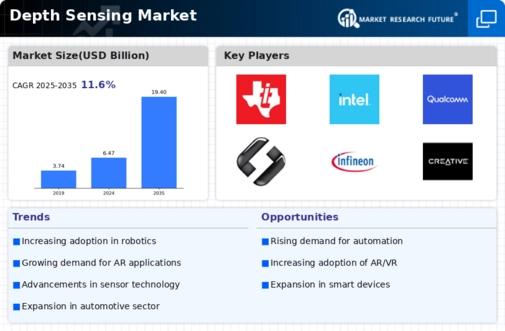Top Industry Leaders in the Depth Sensing Market

Competitive Landscape of Depth Sensing Market:
The depth sensing market is experiencing a vibrant surge, fueled by burgeoning applications across diverse industries. From facial recognition in smartphones to gesture control in gaming, the ability to perceive depth unlocks a plethora of possibilities. This dynamic landscape is teeming with established players, emerging challengers, and a constant churn of strategies. To navigate this complex terrain, a thorough understanding of the competitive milieu is crucial.
Key Players
- Texas Instruments
- Intel
- Qualcomm
- Stereolabs
- Infineon Technologies
- Creative Technology
- pmdtechnologies AG
- Nerian Vision Technologies
- Melexis
- Tower Semiconductor
Strategies Adopted by Key Players:
In this competitive landscape, success hinges on adopting strategic approaches. Established players are diversifying their portfolios, venturing into new application areas and collaborating with startups to access cutting-edge technology. Intel, for instance, has partnered with AR headset manufacturers to integrate RealSense sensors, while Microsoft is actively involved in open-source projects related to depth sensing. Emerging companies, on the other hand, are focusing on building strong partnerships with established players to leverage their distribution channels and expertise. Additionally, they are actively pursuing M&A opportunities to expand their product offerings and reach new markets.
Factors for Market Share Analysis:
- Technology Portfolio: The breadth and depth of a company's technology offerings play a crucial role. Players with diverse sensor types (ToF, structured light, LiDAR) and robust software stacks cater to a wider range of applications, gaining a competitive edge.
- Cost and Performance: Striking the right balance between affordability and performance is key. Low-cost, high-performance solutions democratize access to depth sensing, expanding the market reach.
- Vertical Market Focus: Companies that cater to specific industry needs with tailored solutions stand out. Expertise in areas like robotics, automotive, or healthcare creates strong customer loyalty and market dominance in those segments.
- Partnerships and Collaborations: Strategic partnerships and collaborations can accelerate growth. Teaming up with leading device manufacturers or software developers expands distribution channels and unlocks new application possibilities.
New and Emerging Companies:
- Blickfeld: Pioneering LiDAR solutions for autonomous vehicles with exceptional range and accuracy.
- Occipital: Developing advanced depth cameras with built-in AI processing, enabling real-time object recognition and tracking.
- Evisort: Offering cloud-based depth sensing analytics platforms for retail and logistics applications.
Latest Company Updates
Texas Instruments:
- October 25, 2023: TI announces the DLP3030 chip, a high-resolution (1080p) ToF projection engine for industrial and automotive applications.
- September 2023: TI partners with Qualcomm on a reference design for AR glasses using TI's DLP technology and Qualcomm's Snapdragon XR2 platform.
Intel:
- September 20, 2023: Intel announces the RealSense Depth Camera D455, a high-precision, stereo vision depth camera for industrial automation and robotics.
- August 2023: Intel partners with Microsoft on a project to develop depth-sensing technology for next-generation HoloLens devices.








